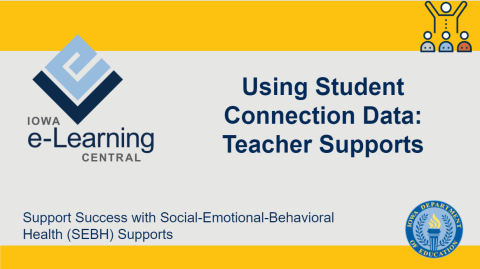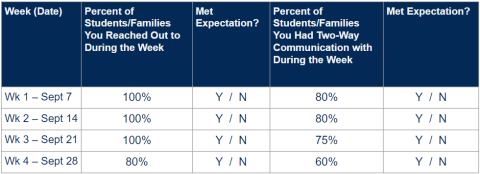
Click the link below for the
Using Student Connection Data:
Teacher Supports module
The full version of the module is in the downloadable PDF above. An accessible text version is below.
Support Success with Social-Emotional-Behavioral Health (SEBH) Supports - Using Student Connection Data: For Teachers
The Teacher Supports module is one of two modules designed to help learn how to analyze student and family connection information. Module also includes action plan ideas. Other modules are available through the Support Success with SEBH Supports.
Purpose & Objectives
This is one of a set of modules that highlight critical considerations and provide universal strategies to support the social-emotional-behavioral health of staff, students, and families during in-person and/or online learning.
Each module is:
- a “jump-start” to key considerations, with less focus on systemic changes
- designed to be completed in 30 minutes or less
- for educators/teachers
- self-paced but may be facilitated
- optional; educators may use one or more depending on need
Supporting Social-Emotional-Behavioral Health
Staff, family, and student emotional well-being is integral to effective instruction and student engagement. Planning for this support is critical to ensure adults and learners are ready to learn.
Teachers with Strong Social-Emotional Competence...
- Have less burnout
- Have stronger student relationships
- Regulate their own emotions
- Are social-emotional role models
Students with Strong Social-Emotional Competence...
- Have increased achievement
- Have improved attitudes
- Have less emotional distress
- Have fewer conduct concerns
Alignment to State Priorities and Goals
State Priority: Creating a Safe, Healthy, and Welcoming Learning Environment
- Goal: All Iowa schools will work with their learners to foster a culture and climate in which they feel safe and supported, and bullying and harassment do not exist.
- Goal: All learners will have access to mental health services and supports in their schools and communities.
- Goal: All schools will create environments that develop social, emotional, and behavioral health.
- Goal: All schools will develop physical health for students through structured school programs (e.g., food and nutrition, physical education, wellness programs, etc.)
Connecting to your work
How do these recommendations connect to your work?
The practices outlined in the following modules align to:
- Best practices detailed within many policy expectations for schools
- Evidence Based Practices (EBPs) for SEBH
- Universal Supports for SEBH within an MTSS
The purpose of these resources is to apply EBP for SEBH within the context of a variety of learning contexts including in-person, online, and virtual.
Using Data to Support Student/Family Connections: Teacher Supports
Objectives
- Analyze problems in making student/family connections by asking informational questions.
- Review common areas of need and corresponding practices for improving student/family connections.
Positive and consistent home-school connections are foundational to learning. This module is designed to help individual educators intentionally connect with and support families and students.
Key Terms
Student/Family Connection – Staff-initiated contact with students and/or the family of the student to establish and maintain a caring and consistent point-of-contact with the school
Touch-Point – Intentional interactions initiated by staff with students/families, providing a consistent point-of-contact for student learning and well-being
Adult-Student/Family Connection (ASC) – 2-way communication between staff and the student and/or the student’s family
Reached Out (R) – 1-way communication initiated by staff
Teacher Connection Log Review Process
- Gather your student connection log
- Assess your connections with students/families
- Reflect on your connections with students/families
- Identify student or family specific needs
- Develop a personal action plan
You can use the Student Connection Log - Teacher Review to document your review process and action plan.
Part I – Assess Your Connections with Students/Families
- Determine the expectation for student/family connection.
- Recommended expectation: Teacher connects with students at least once a week every week,OR
- District or building-level expectation for connecting with students
- Calculate the percent of students/families you reached out to each week.
- Calculate the percent of students/families you contacted and achieved a connection.
- Determine if you did or did not meet the expectation each week.
Part I – Assess Student/Family Connections
Ms. Smith is a 7th grade English teacher. Throughout this module, you will see her Student Connection Log data. Each time, you have the opportunity to review and reflect upon her data set.
Expectation: Reach out to 100% of students each week and have an adult-student connection with at least 80% of the students each week

Time to Reflect:
Did the teacher meet the expectations?
Part II – Reflect on Your Contacts with Students/Families
-
What:
- Are you reaching out to students/families as expected?
- Are students/families responding to contacts when attempted?
- Are you making meaningful connections with students/families?
-
How:
- Which communication method(s) yielded the most responses in connecting with students/families?
- Which communication method yielded the least responses?
-
When:
- Are there patterns when students/families respond to attempted contacts?
- Are there times of the day or days of the week when you are more successful in connecting with students/families?
- If so, when?
-
Who:
- Are there students/families for whom you have consistent difficulty making a connection?
- Are there students/families that you haven’t been able to reach?
-
Why:
- What are the barriers to making successful connections?
- What are your personal barriers to reaching out?
- What might be some student/family barriers to successful connections?
Part II – Personal Reflection
Take some time to review what Ms. Smith thought about as she answered the what, how, when, who, and why questions.
What: I’m trying to reach out but am struggling as the things are picking up this school year. I don’t seem to have enough time.
How: I’ve been trying to call students/families this past month. It takes a lot of time to call and I often have to leave messages. Even if parents/students call back, I end of up playing phone tag with them.
When: I’ve been calling in the day during my planning period.
Who: I have never been able to reach Mariah and Marcus. I have a hard time reaching Swift and often play phone tag with him or his parents.
Why – Individual Teacher: Time
Why – Student/Family: I’m not sure Tran or his parents totally understand me. The voice mailbox for Samantha is full and I can’t leave messages.
Time to Reflect:
What do you notice from the teacher’s reflection?
Barriers to Reaching Out and Connecting
Below is a list of barriers and potential solutions.
- Local expectations for communication are unclear
- Seek clarity on the expectations from the administrator
- Student contact information not readily available
- Create a contact directory, program phone numbers into your cell phone, enter email contacts into your computer
- Accuracy of contact information
- Ask secretary to verify contact information
- Language barrier is impacting communication
- Identify district means to translate (i.e. School Connects, Google Translate, interpreter), try alternate means of translated communication
- Day of the week or time of the contacts
- Change day/time of making contacts, maintain consistent pattern of communication so families and students can plan to receive communication
- Effectiveness of communication method (e.g., phone, email, text, driveway visit)
- Try alternate communication method(s), survey to determine preferred method
- Lack of adequate time to make connections
- Schedule protected time to reach out, schedule regular ‘appointment’ check-ins, spread out contacts throughout the week, provide recorded group messages (e.g., recorded Zooms, YouTube) accessible 24/7
Reflection Time!
Using the teacher’s reflection and the strategies you just read about, what might be some potential solutions you would try if you were the teacher?
Part III – Identify Student/Family Needs
- Identify student/family needs
- Identify which needs you can address as a teacher
- Identify district-supported and community resources and district referral processes with respect to:
- Basic Needs (e.g., food, housing, childcare, health care)
- Social and Emotional Well-Being
- Technology Needs
- Communicate results from Conditions for Learning survey, locally developed survey, or from student/family connections with the administrator.
- Assist families by providing supported resources or initiating the district referral process for accessing community resources; follow-up with families on previous referrals
Part IV – Develop an Action Plan
- Write a problem statement based on your data and reflections
- Identify your hypothesis (-es) of what you think will impact student/family connections
- Identify your goal for the next month
- Identify the specific action steps you want to take to maintain or improve your student/family connections
Action Plan
Ms. Smith wrote a summary problem statement and thought about things she could try in the next few weeks. She identified 3 actions. Take time to read her information and reflect on the actions she decided to try next.
Problem Statement:
I met expectations 2/4 weeks and was better at the beginning of the month. I’ve only tried making phone calls during my planning period. I’ve never reached Mariah and Marcus and I’m not sure Tran understands me over the phone.
Goal:
Reach out to 100% of the students each week and connect with at least 80% of them.
Actions:
- Try text messages and emails instead of calling to see if I get a better response rate.
- Double-check contact information for Mariah and Marcus.
- Look up Tran’s English proficiency information to determine if I need to ask an interpreter for help.
Time to Reflect:
Did your ideas match what this teacher put in the action plan?
Follow-Up Activity #1: Personal Planning
It’s your turn!
You just learned how to review student connection data as a leadership team. Go and get your data and complete the review protocol with your team members. It’s good practice meet monthly as a leadership team to review the data to ensure staff are connecting with your students and families.
- Complete each part of the Student Connection Log - Teacher Review
- Develop your own action plan

Follow-Up Activity #2: Additional Strategies to Improving 2-Way Connections
Here are three additional strategies for the team to consider using in the action plan. Take time as a team to dig into the resources and determine which ones you may want to share with staff to add to the ‘toolbox’ of relationship resources.
Review the additional strategies and resources as a Leadership Team. Identify at least one to share with staff in the upcoming month.
- Revisit Student/Family preferences in making connections
- Survey family preferences for the method and day/time of communication
- Consider relationship mapping to identify positive connections (virtual) (in-person)
- Review Best Practices in Family School Engagement
- Build Relationships
- Check in with the parent/student as a person – validating challenges and efforts
- Consider adopting a structuring conversation
- Engage in additional relationship activities to build resilience
- Give opportunities to request additional check-ins (i.e. Distance learning check-in)
- Ensure timely follow-up
- Consider developmental age of student and format of response
- Limit depth of questioning in survey form. Reserve deeper questions for personal interaction.